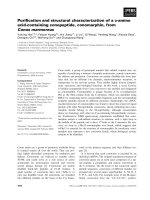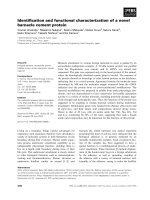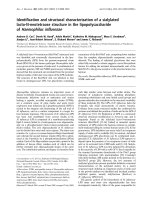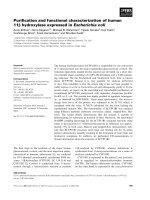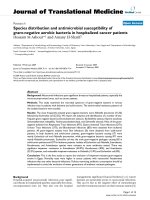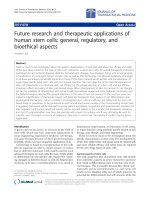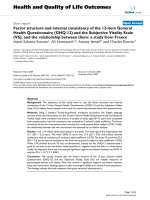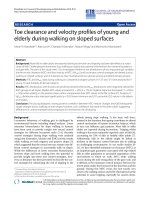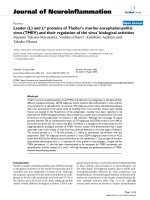Báo cáo hóa học: "Reference values and physiological characterization of a specific isolated pig kidney perfusion model" doc
Bạn đang xem bản rút gọn của tài liệu. Xem và tải ngay bản đầy đủ của tài liệu tại đây (1.25 MB, 13 trang )
BioMed Central
Page 1 of 13
(page number not for citation purposes)
Journal of Occupational Medicine
and Toxicology
Open Access
Research
Reference values and physiological characterization of a specific
isolated pig kidney perfusion model
Volker Unger*
1
, Christian Grosse-Siestrup
1
, Claudia Fehrenberg
1
,
Axel Fischer
2
, Michael Meissler
1
and David A Groneberg
3,4
Address:
1
Department of Comparative Medicine and Facilities of Experimental Animal Sciences, Charité – Universitätsmedizin Berlin, Free and
Humboldt-University Berlin, Augustenburger Platz 1, D-13353 Berlin, Germany,
2
Allergy-Centre-Charité, Otto-Heubner-Centre, Pneumology and
Immunology, Charité – Universitätsmedizin Berlin; Augustenburger Platz 1, D-13353 Berlin, Germany,
3
Institute of Occupational Medicine,
Charité – Universitätsmedizin Berlin, Ostpreussendamm 111, D-12207 Berlin, Germany and
4
Department of Respiratory Medicine, Hannover
Medical School, Carl-Neuberg-Str. 1 OE 6870, D-30625 Hannover, Germany
Email: Volker Unger* - ; Christian Grosse-Siestrup - ;
Claudia Fehrenberg - ; Axel Fischer - ; Michael Meissler - ;
David A Groneberg -
* Corresponding author
Abstract
Background: Models of isolated and perfused kidneys are used to study the effects of drugs,
hazardous or toxic substances on renal functions. Since physiological and morphological
parameters of small laboratory animal kidneys are difficult to compare to human renal parameters,
porcine kidney perfusion models have been developed to simulate closer conditions to the human
situation, but exact values of renal parameters for different collection and perfusion conditions
have not been reported so far. If the organs could be used out of regular slaughtering processes
animal experiments may be avoided.
Methods: To assess renal perfusion quality, we analyzed different perfusion settings in a
standardized model of porcine kidney hemoperfusion with organs collected in the operating
theatre (OP: groups A-D) or in a public abattoir (SLA: group E) and compared the data to in vivo
measurements in living animals (CON). Experimental groups had defined preservation periods (0,
2 and 24 hrs), one with additional albumin in the perfusate (C) for edema reduction.
Results: Varying perfusion settings resulted in different functional values (mean ± SD): blood flow
(RBF [ml/min*100 g]: (A) 339.9 ± 61.1; (C) 244.5 ± 53.5; (D) 92.8 ± 25.8; (E) 153.8 ± 41.5);
glomerular fitration (GFR [ml/min*100 g]: (CON) 76.1 ± 6.2; (A) 59.2 ± 13.9; (C) 25.0 ± 10.6; (D)
1.6 ± 1.3; (E) 16.3 ± 8.2); fractional sodium reabsorption (RF
Na
[%] (CON) 99.8 ± 0.1; (A) 82.3 ±
8.1; (C) 86.8 ± 10.3; (D) 38.4 ± 24.5; (E) 88.7 ± 5.8). Additionally the tubular coupling-ratio of Na-
reabsorption/O
2
-consumption was determined (T
Na
/O
2
-cons [mmol-Na/mmol- O
2
] (CON) 30.1;
(A) 42.0, (C) 80.6; (D) 17.4; (E) 23.8), exhibiting OP and SLA organs with comparable results.
Conclusion: In the present study functional values for isolated kidneys with different perfusion
settings were determined to assess organ perfusion quality. It can be summarized that the
hemoperfused porcine kidney can serve as a biological model with acceptable approximation to in
vivo renal physiology, also if the organs originate from usual slaughtering processes.
Published: 29 January 2007
Journal of Occupational Medicine and Toxicology 2007, 2:1 doi:10.1186/1745-6673-2-1
Received: 16 November 2006
Accepted: 29 January 2007
This article is available from: />© 2007 Unger et al; licensee BioMed Central Ltd.
This is an Open Access article distributed under the terms of the Creative Commons Attribution License ( />),
which permits unrestricted use, distribution, and reproduction in any medium, provided the original work is properly cited.
Journal of Occupational Medicine and Toxicology 2007, 2:1 />Page 2 of 13
(page number not for citation purposes)
Background
A variety of isolated and perfused kidney models has been
used for the study of renal functional parameters [1-6]. If
the kidneys are perfused normothermically with autolo-
gous blood, they exhibit unique possibilities for pharma-
cology and toxicology studies and for the improvement of
the graft function after transplantation. As the donor kid-
neys are subject to warm and cold ischemia due to the
explantation process and the preservation [7-10], the
investigation of ischemia- and reperfusion-related injuries
[11-15] which cause a great number of organ failures, is
still very important.
While easy in use, the perfusion of small laboratory ani-
mal kidneys has often been unsatisfactory since the renal
function of these animals largely differ in comparison to
the human organ [16-18]. In contrast to the situation in
rodent organisms, the functional morphology of porcine
kidneys is closer to the situation in humans. Therefore
porcine kidney perfusion systems are often used in exper-
imental nephrology [1,19-21].
Next to the renal anatomy and function, a further advan-
tage of porcine organs is based on the availability of
organs from commercially slaughtered animals. The use
of these slaughterhouse kidneys can lead to the reduction
in the number of experimental animals. Legally, slaugh-
terhouse kidney perfusion studies are not defined as ani-
mal experiments and therefore fulfill international
standards in terms of establishing alternatives to animal
experimentations [22].
Many perfusion settings exist for porcine kidney perfusion
models but reference values for different perfusion condi-
tions have not been defined so far. Physiological reference
values out of in vivo animal studies are of limited mean-
ing for the validation of the isolated kidney function due
to the organ's separation from extra-organic nervous and
humoral control mechanisms. For example strong poliu-
ric states with urine flow rates of 10 ml/min and more
may occur, caused partly by the absence of ADH control
in this kidney model.
Therefore the present study was performed, to define com-
parative values of renal functional parameters in both,
laboratory and slaughterhouse harvested isolated porcine
kidneys. The organs were studied under different preserva-
tion and perfusion conditions and were compared to the
in vivo renal function of pigs. Physiologically the focus
was set 1.) on the glomerular filtration, determined by the
exogenous creatinine clearance [23-25] and 2.) on post-
glomerular mechanisms, controlling renal sodium han-
dling. Sodium reabsorption is an active, oxygen-
consuming process dependent upon sodium potassium
pumps [26-28]. This had been studied already for the iso-
lated kidney of the rat [29] and also for the state of pos-
tischemic acute renal failure [30]. The metabolic coupling
between the sodium reabsorption and the oxygen con-
sumption [31-34] therefore is used here as a further indi-
cator for the performance of the isolated pig kidney.
Materials and methods
Animals and experimental groups
After approval of the local official veterinarian institu-
tions, German landrace female pigs (age six months) were
used. Six differently treated groups (table 1) were ana-
lyzed for reference values. Kidneys from four groups were
collected from laboratory animals in an operating theatre
(A-D), kidneys of group E originated from slaughterhouse
animals at an abattoir. Whereas in group (A) no preserva-
tion at all took place, the organs of the groups B-E were
preserved before hemoperfusion (B, C, : 2 hrs, D 24 hrs, E
about 5 hours due to the process of slaughtering and
transport). In group C, albumin was added to the per-
fusate to approximate physiological colloid osmotic pres-
sure with the two aims: 1.) to normalize effective filtration
pressure relations in the glomerula of the kidney and 2.)
to reduce the danger of edema.
The control group (CON) originated from 8 living labora-
tory animals, kept under controlled conditions for 1 week
in the stables of the facility, inhouse with the laboratories
and the operation room. The animals were provided with
blood access via a cannulated external jugular vein for
three days. On the second day of this period the individ-
ual animals were hold in a metabolic cage for the purpose
of 24 hour urine collection. The individual three day
mean values of the blood samples and the 24 hour urine
values were used as basic data for the CON group.
Selected results from group CON had already been pre-
sented in part in a previously published methodological
study [35] to demonstrate a new graphical depiction
method.
Blood collecting
For the collection of blood of the slaughterhouse animals,
as previously described in detail [19,36]., the cervical ves-
sels (Venae jugularis dex.et sin., V. cava cranialis) were
punctured and the collected blood was anticoagulated
with sodium citrate (18 ml/l) and heparine (5.000 IE/l).
The blood was then filtered (Biotest TNSB-3 transfusion
device, 200 μm) and stored in sterile blood bags [2]. Alter-
natively, in the laboratory animals group, blood was col-
lected under sterile conditions via the cannulated external
jugular vein.
Organ collecting
The pigs of the slaughterhouse groups were electrically
stunned and then exsanguinated. Then the organs were
Journal of Occupational Medicine and Toxicology 2007, 2:1 />Page 3 of 13
(page number not for citation purposes)
removed by en bloc technique, arterially cannulated and
flushed with preservation solution (4°C) containing
5.000 IE/L heparine (Liquemin N, Roche). 500 ml of pres-
ervation solution (see table 2 for B2-solution pursuant to
von Baeyer [8]) was then applicated into the artery and
the kidneys were transferred under sterile, hypothermic
(4°C) conditions from the abattoir to the laboratory.
Kidneys from laboratory animals were handled in the
same way after being removed surgically. For organ har-
vesting by surgery, pigs were set under general anesthesia
undergoing median laparotomy. The right external jugu-
lar vein was cannulated and the animal was heparinized
(300 IE/kg body weight). Kidneys were removed and can-
nulated one by one before the animal was exsanguinated.
Normally one kidney was perfused immediately and the
other underwent the preservation procedure before the
reperfusion.
Perfusion procedures
Perfusion procedures were carried out as previously estab-
lished for kidneys and other organs [19,37,38]. Ureteral
and vascular catheters were implanted and a period of
warm rinsing with 500 ml of preservation solution was
performed before hemoperfusion with autologous blood
was conducted. The hemoperfusion started with an arte-
rial flow of 50–100 ml/min and a mean arterial pressure
never allowed to exceed 100 mmHg to ensure an optimal
organ warming up and the beginning of renal autoregula-
tion under reperfusion. Blood and urine samples for
assessment of parameters were collected after entering a
steady state usually after 20–30 min. Then, within clear-
ance periods of 30 min, urine collection and blood sam-
pling was performed and immediately followed by blood
gas analysis using an automated blood gas analysator
(Radiometer Copenhagen, ABL) to assess pH- and electro-
lyte status. Further sample fractions were stored for a later
Table 2: Preservation solutions [8]
B2 HTK Euro Collins
Osmolality (mosm/kg) 323 310 406
Ions (mmol/l) Na
+
22 15 10
K
+
150 9 115
Mg
++
10 4
Cl
-
10 50 15
SO4
-
85
Buffers (mmol/l) PO4
6
HPO4
43
H2PO4
-
15
HCO3
-
10
Histidin 198
Osmotics (mmol/l) Glucose 198
Mannitol 30
Saccharin 40
Colloids (mmol/l) PEG 25
Table 1: Isolated kidney experimental groups
Group Organ Harvesting Preservation time (ca. hrs) Preservation medium Oncotic medium Organ numbers
A OP no no - 16
B OP 2 B2 - 16
C OP 2 B2 ALB 16
D OP 24 B2 - 8
E SLA 5 B2 - 16
CON 8
(OP: laboratory animal kidneys collected in the operating theatre; SLA: slaughterhouse organs; B2: von Baeyer solution; ALB: albumin added to the
perfusate)
Journal of Occupational Medicine and Toxicology 2007, 2:1 />Page 4 of 13
(page number not for citation purposes)
transfer to the labotaratory for analysis of multiple other
parameters as listed below. Also, venous and arterial pres-
sures and arterial flow were recorded online using ultra-
sonic flow transducers (Transonic Systems Inc., T206).
Organ weight was also assessed directly after surgical
resection (prior to eventual cold storage) and before and
after reperfusion.
Perfusion system
The perfusion system consisted of separated blood and
dialysis circuits as described [2], that may also be used for
the perfusion of other organs and tissues, like the liver
[39,40], the heart [41] or the skin [38]. The volume of
heparinized (20.000 IE/l) blood was 600 ml, added with
standard electrolyte solution (modified Tyrode's solu-
tion) to adjust pressures and hemoglobin concentration
and to replace urine fluid loss.
The blood was pumped from the reservoir to a low-flux
polysulfon dialysis system (model F7, Fresenius, Bad
Homburg). Next to dialysis processes, the blood was also
oxygenized in this module and then transported to the
organ with a second roller-pump. After passage through
the organ, the blood reached the reservoir due to hydro-
static pressure differences.
The dialysis circuit containing 10 000 ml of dialysate
medium (modified Tyrode's solution) was driven by a
roller pump. The dialysate circuit meets the metabolic
demands of the organ and, therefore, is permanently oxy-
genated and nutritional substrates are added as well as cre-
atinine for the determination of the exogenic creatinine-
clearance. The substrates are periodically controlled for a
steady state in the composition of the dialysate. The tem-
perature was adjusted to 38°C. Controlling of ultrafiltra-
tion und thus the perfusate dilution was maintained by
continuously weighing the blood reservoir and balancing
the afferent and efferent blood roller pumps. The kidneys
were kept in a body warm plexi-glass chamber. Urine was
collected by way of a ureteral catheter in calibrated glass
cylinders.
Parameters
Apart from basic experimental data (table 3: weight
parameters, ischemia time, perfusion time), hemodynam-
ics and blood gases, hemoglobin, blood and urine pH and
different electrolytes, the following parameters were
measured: free hemoglobin (mg/dl), total blood protein
(g/dl), creatinine-concentration in blood (mg/dl) and
urine (g/l), urine flow (ml * min
1
* 100 g
-1
). By use of the
described formulae (see appendix) the following parame-
ters were determined: creatinine clearance (Cl
crea
, ml *
min
1
* 100 g
-1
), fractional water reabsorption (RF
H2O
, %),
fractional sodium reabsorption (RF
Na
, %), tubular
sodium transport (T
Na
, mmol * min
-1
* 100 g
-1
). Results
are presented for the steady state of the model as 60 min
values (hematology: table 4; blood, urine laboratory:
table 5) and additionally with the 3 hour state for hemo-
dynamics and renal functional parameters (table 6).
Table 3: Basic experimental data for isolated kidney experimental groups and for the control group CON of living pigs
group CON A B C D E
Kidney-Weight g mean 86,1 116,9 113,1 103,9 144,1 165,3
SD 8,3 11,4 17,3 18,6 22,5 57,6
Preservation- Time hrs mean ••2,04 2,01 24,14 5,20
SD • • 0,35 0,04 1,04 0,84
Warm Ischemia Time min mean • 7,3 8,8 6,9 7,9 17,8
SD • 2,1 2,8 1,6 2,4 7,3
Signif.)* EE E EE D
Perfusion-Time min mean • 206,9 218,5 213,8 207,3 197,3
SD • 12,9 28,9 10,6 17,3 18,4
Weight Gain Preservation % mean ••10,3 11,9 5,1 9,8
SD • • 10,2 12,7 5,6 9,4
Signif.)* DD D
Weight Gain Perfusion % mean • 39,6 28,7 15,3 26,0 31,2
SD • 19,2 17,5 11,1 9,1 21,1
Signif.)* B;CC;D C D D
(Signif* = Significance is denoted by capital letters labelling the resp. target group for comparison, as well as the level of significance: simple (p <
0.05) = single capital, high (p < 0.01) = twin capitals)
Journal of Occupational Medicine and Toxicology 2007, 2:1 />Page 5 of 13
(page number not for citation purposes)
Constructing the diagram (figure 1)
To analyze the influence of multiple determands on com-
plex kidney function parameters, a grapho-analytical
method was used, which is described in detail in a previ-
ously published article for analyzing nephrological
parameters [35]. This nomogram-like method is applied
here to examine the creatinine clearance used as approxi-
mation of the glomerular filtration rate (GFR).
The creatinine clearance represents the mathematical
product of the U/P
crea
quotient and the urine-flow VU.
Directly displaying these two terms in a x-y diagram leads
to certain curves for similar Cl
crea
. values in each experi-
mental group, which are difficult to be distinguished from
each other. Therefore the x, y data are transformed into
logarithmic scaling and linear lines instead of curves are
resulting for constant values of the creatinine clearance. In
that way figure 1 was constructed and the interrelation of
the following parameters can be analyzed: creatinine U/P
quotient (U/P
crea
), urine-flow (VU), creatinine-clearance
(Cl
crea
). As a fourth parameter, the fractional reabsorption
of water RF
H2O
(see appendix for the formula) can be dis-
played, since the reciprocal expression of the U/P
crea
quo-
tient, arranged as (1- P/U
crea
), represents the water
reabsorption along the tubular system which is numeri-
cally present in the second scale of the y-axis in figure 1.
Statistics
All assessed data are expressed as mean ± standard devia-
tion (SD). Statistical significance (p < 0.05) was tested
using StatView 4.5 for Apple Macintosh: the Mann-Whit-
ney-U test for interindividual (group) differences, the Wil-
coxon matched pairs test for intraindividual (pairwise)
testing and ANOVA regression statistics.
Results
Value differences determined as statistically significant (p
< 0.05) are denoted in the tables and notation is explained
in the respective captions in detail.
General parameters
The basic experimental data are presented in table 3. The
studies in groups A-D with kidneys obtained in the oper-
ating theatre (OP) were performed under comparable
conditions regarding animals, organs, harvesting proto-
cols and warm ischemia time. The latter is significantly
increased in group E, the abattoir originating organs (SLA)
(table 3). The weight gain of the organs after preservation
shows a homogenous range of about 10 % with the signif-
icant exception of group D (5.1 %). The weight gain of the
organs after reperfusion exhibits comparable values of
about 30 % for groups B, D, E. Significant alterations were
found for group A with 39.6 % and with a decrease to 15.3
% for the albumin group C.
Blood and urine parameters
Hematology values are presented in table 4. The hemo-
globin (and also the hematocrit in direct proportionality)
shows comparable value levels of about 7 g/dl for groups
A, B, E, increased values of 9.1 g/l for groups CON, C and
a maximum of 10.2 g/l for group E. The free plasma
hemoglobin exhibits the lowest value of 6.1 mg/dl in the
CON-group, light elevated values of 11.4 mg/dl (group C)
and 12.9 mg/dl (group A) and significant alterations from
Table 4: Hematology values at 60 min hemoperfusion for isolated kidney experimental groups and for the control group CON of living
pigs
Blood
groups CON A B C D E
Hemoglobin g/dl mean 9,1 7,0 7,5 9,1 10,2 7,2
SD 0,4 1,3 1,4 1,6 2,7 1,5
Signif.)* A;E
Hematocrit mean 0,32 0,22 0,24 0,29 0,31 0,23
SD 0,02 0,04 0,04 0,05 0,09 0,05
Signif.)* A;E
Free Hemoglobin mg/dl mean 6,1 12,9 26,8 11,4 93,0 46,8
SD 1,3 6,1 33,6 4,1 26,1 29,7
Signif.)* AA DD;EE DD DD;EE
COP mmHg mean 17,4 6,4 6,9 16,8 6,3 5,8
SD 3,1 1,9 2,9 5,2 2,4 2,2
Signif.)* AA CC CC DD;EE
(Signif* = Significance is denoted by capital letters labelling the resp. target group for comparison, as well as the level of significance: simple (p <
0.05) = single capital, high (p < 0.01) = twin capitals)
Journal of Occupational Medicine and Toxicology 2007, 2:1 />Page 6 of 13
(page number not for citation purposes)
this level for groups E (46.8 mg/dl) and D (93 mg/dl). The
colloid osmotic pressure (COP) shows a comparable
value level of around 6 mmHg for groups A, B, D, E with
significant exceptions for group CON (17.4 mmHg) and
the albumin group C (16.8 mmHg).
Laboratory parameters for both blood and urine are pre-
sented in table 5 for the collection time at 60 min after
start of the perfusion. Generally the blood parameters
were kept in approximation to the physiological ranges by
periodically controlling the composition of the dialysate
(see methods section) and therefore no significant altera-
tions were found, with the exception of creatinine. Creat-
inine was added to the perfusate for the purpose of
determination of the exogenous creatinine clearance,
resulting in 3–4 fold concentration levels in comparison
to the natural blood values, determined as 1.05 mg/dl in
the CON-group.
For all measured urine parameters the situation between
the control group CON and all experimental groups A-E is
characterized by statistically strong significant (p < 0.01)
differences (compare table 5). Additionally there were
some significant value differences between single experi-
mental groups for the following parameters:
Potassium concentration with 8.7 mmol/l for group A was
found significantly lower than the values for groups B
(18.5 mmol/l), D (20.3 mmol/l) and E (25.7 mmol/l).
Sodium for group A (108.9 mmol/l) was significantly dif-
ferent from lower values in groups B, C, E and also from
the increased value measured for group D (131.1 mmol/
l). Creatinine concentration ranged between 0.13 and
Table 5: Laboratory values for blood and urine at 60 min hemoperfusion of isolated kidney experimental groups and for the control
group CON of living pigs
Blood Urine
groups CON A B C D E CON A B C D E
Potassium mean mmol/l 3,84 3,8 4,6 4,7 5,9 5,7 mmol/l 87,1 8,7 18,5 12,7 20,3 25,7
SD 0,13 0,6 0,4 0,9 0,7 0,9 3,3 6,1 11,9 7,0 17,1 13,9
Signif.)* B;D;E D;E AA;BB;CC;
DD;EE
B;D;E
Sodium mean mmol/l 141,7 140,7 136,2 139,1 131,2 134,7 mmol/l 25,1 108,9 82,2 88,8 131,1 83,9
SD 1,2 5,2 4,6 5,2 1,6 3,6 2,5 18,7 16,0 23,6 38,4 24,4
Signif.)* D D AA;BB;CC;
DD;EE
B;C;D;E D D D
Osmolality mean mosm/kg 291,2 281,5 283,7 288,1 275,8 289,9 mosm/kg 685,9 244,8 221,4 255,2 311,5 274,7
SD 8,4 9,9 7,7 11,4 2,1 8,9 90 24,0 33,1 63,2 133,7 57,6
Signif.)* AA;BB;CC;
DD;EE
DDD
Creatinin mean mg/dl 1,05 2,5 3,4 3,5 4,9 3,7 g/l 0,98 0,13 0,15 0,34 0,08 0,22
SD 0,12 0,7 0,6 0,4 1,5 0,9 0,13 0,07 0,07 0,41 0,06 0,08
Signif.)* A;B;C;D;E D AA;BB;C;
DD;EE
CCD D
Urea mean mg/dl 21,1 19,1 22,6 22,7 27,8 24,5 g/l 17,6 0,66 0,74 1,13 0,58 0,96
SD 1,5 3,9 2,5 1,7 3,0 2,2 4,0 0,18 0,28 0,38 0,34 0,17
Signif.)* AA;BB;CC;
DD;EE
CDD
Glucose mean mg/dl 109,4 135,3 115,8 124,6 112,8 112,3 g/l <= 0,1 0,24 0,17 0,38 1,13 0,63
SD 9,2 17,9 15,0 22,7 9,5 6,7 0,19 0,14 0,29 0,16 0,34
Signif.)* (AA;BB;CC;
DD;EE)
DD;E DD;E DD D
Protein mean g/dl 5,4 3,8 4,0 5,7 3,8 2,7 mg/l 117 233 435 1087 10008 1862
SD 0,2 0,9 1,0 1,0 0,8 0,8 25 207 423 1203 3570 2340
Signif.)* A C C A;BB;CC;
DD;EE
B;C;DD;E C;DD;E D D
pH mean 7,38 7,44 7,39 7,55 7,53 7,53 6,13 6,89 6,70 7,07 6,31 6,88
SD 0,15 0,17 0,09 0,24 0,08 0,09 0,19 0,24 0,33 0,26 0,47 0,39
Signif.)* A;B;C;E
(Signif* = Significance is denoted by capital letters labelling the resp. target group for comparison, as well as the level of significance: simple (p <
0.05) = single capital, high (p < 0.01) = twin capitals)
Journal of Occupational Medicine and Toxicology 2007, 2:1 />Page 7 of 13
(page number not for citation purposes)
0.15 g/l for groups A and B and differed significantly from
this level in group C (0.34 g/l) and D (0.08 g/l).
Urea showed a value range from 0.58 to 0.74 g/l for
groups A, B, D with a significant difference for group C
(1.13 g/l).
A glucose concentration range between 0.17 and 0.38 g/l
for groups A, B, C was significantly surpassed in group D
(1.13 g/l).
Protein urine concentration measurements revealed three
groups with significantly increased levels: group C (1.09
Table 6: Hemodynamic and renal functional parameters at 60 and 180 min hemoperfusion of isolated kidney experimental groups and
for the control group CON of living pigs
group CON A B C D E
RBF Bloodflow ml/min*100 g 60 min ● 339.9 224.8 244.5 92.8 153.8
SD • 61.1 28.4 53.5 25.8 41.5
Signif.)* BB;CC;DD;EE DD;E DD;EE D
180 min ● 363.0 241.1 285.5 107.9 160.1
SD • 58.0 19.4 48.5 28.4 54.8
R Organ- Resistance mmHg/(ml/min*100 g) 60 min ● 0.29 0.44 0.37 1.26 0.61
SD • 0.05 0.06 0.11 0.49 0.17
Signif.)* BB;C;DD;EE DD;E DD;EE DD
180 min ● 0.28 0.4 0.29 1.01 0.61
SD • 0.08 0.03 0.07 0.31 0.19
O2-cons Oxygen- Consumption μmol/min*100 g 60 min ● 263.9 214.3 141.6 120.8 206.4
SD • 49.4 22.3 21.6 27.6 43.5
Signif.)* BB;CC;DD;EE CC;DD EE DD
180 min ● 246.4 213.6 142.9 116.2 198.9
SD • 39.4 22.9 19.0 27.6 36.8
VU Diuresis ml/min*100 g 60 min 0.87 13.4 7.2 5.1 0.7 3.0
SD 0.25 6.1 4.7 3.8 0.3 2.3
Signif.)* AA BB;CC;DD;EE DD;E DD;E DD
180 min ● 14.4 8.9 5.7 0.4 3.2
SD • 6.2 5.1 3.2 0.3 2.4
Cl
crea
Creatinine Clearance ml/min*100 g 60 min 76.1 59.2 27.6 25.0 1.64 16.3
SD 6.2 13.9 7.5 10.6 1.26 8.2
Signif.)* A BB;CC;DD;EE DD;EE DD;E DD
180 min ● 65.9 30.5 24.1 1.04 15.2
SD • 10.5 4.8 7.5 0.89 9.7
FF Filtration- Fraction % 60 min ● 22.5 15.7 14.9 2.7 13.3
SD • 7.2 6.7 5.3 2.5 6.4
Signif.)* • B;CC;DD;EE DD DD DD
180 min ● 24.8 16.4 11.7 1.1 11.9
SD • 7.2 2.5 3.6 1.1 7.2
RF
H2O
Water- Reabsorption- fraction % 60 min 98.9 76.7 72.4 79.6 35.4 81.6
SD 0.3 9.5 12.8 13.2 31.3 17.2
Signif.)* AA DD DD;E DD DD
180 min ● 76.0 70.9 72.6 36.1 74.4
SD • 11.1 15.8 23.3 31.6 30.0
RF
Na
Sodium- Reabsorption- fraction % 60 min 99,8 82,3 83,1 86,8 38,4 88,7
SD 0,1 8,1 10,4 10,3 24,5 5,8
Signif.)* AA DD DD DD DD
180 min ● 80,9 79,4 81,0 46,5 89,4
SD • 7,9 13,9 18,3 31,4 6,0
T
Na
Sodium- Reabsorption mmol/min*100 g 60 min 10,8 6,83 3,16 2,91 0,12 1,98
SD 1,0 2,1 1,0 1,3 0,1 1,08
Signif.)* AA BB;CC;DD;EE DD DD DD
180 min ● 7,82 3,43 2,77 0,09 2,02
SD • 1,6 0,7 1,0 0,1 1,1
(Signif* = Significance is denoted by capital letters labelling the resp. target group for comparison, as well as the level of significance: simple (p <
0.05) = single capital, high (p < 0.01) = twin capitals)
Journal of Occupational Medicine and Toxicology 2007, 2:1 />Page 8 of 13
(page number not for citation purposes)
g/l), D (10.0 g/l) and E (1.86 g/l) when compared to
groups A and B with a value range from 0.23 to 0.44 g/l.
Functional parameters
Table 6 shows functional parameters for the hemodynam-
ics, oxygen consumption and for the renal functions at
two perfusion time levels: 60 and 180 min. Value differ-
ences determined as statistically significant are denoted in
table 6 in detail.
Hemodynamics
Hemodynamics were kept in controlled constant ranges
along the group internal perfusion course concerning the
arterial blood pressure, never allowed to exceed 100
mmHg in the mean. Large intergroup differences in the
organ vascular resistances R are therefore reflected in sig-
nificant differences of the blood flow with a maximum
value at group A (339.9 ml/min*100 g) and a minimum
at D (92.8 ml/min*100 g). A decreasing vascular resist-
The U/P quotient of creatinine U/P
crea
versus urine flow VU for isolated kidney experimental groups A – E and for the control group of living pigs (CON) (Cl
crea
= clearance of creatinine; RF
H2O
= fractional water reabsorption)Figure 1
The U/P quotient of creatinine U/P
crea
versus urine flow VU for isolated kidney experimental groups A – E and for the control
group of living pigs (CON) (Cl
crea
= clearance of creatinine; RF
H2O
= fractional water reabsorption).
Journal of Occupational Medicine and Toxicology 2007, 2:1 />Page 9 of 13
(page number not for citation purposes)
ance in all experimental groups during the perfusion
course allowed the blood flow to increase within 5–17 %
(maximal in group C) between the 60 min and the 180
min state.
Oxygen consumption (O
2
cons)
The oxygen consumption exhibits analogy to the
described hemodynamic situation at the 60 min state with
values ranging between 263.9 μmol/min*100 g (group A)
and 120.8 μmol/min*100 g (D).
Hemodynamics and oxygen consumption were not measured in
the control animals (CON).
Diuresis (VU)
The diuresis was 15-fold in group A compared to the con-
trol value of intact animals (0.9 ml/min*100 g). The other
groups ranged between 3.0 (group E) and 7.2 ml/
min*100 g (group B). In group D a minimum of 0.7 ml/
min*100 g was measured.
Creatinine clearance (Cl
crea
)
Creatinine clearance values reached approx. 80% of the
control (76.1 ml/min*100 g) in group A (59.2 at 60 min,
65.2 ml/min*100 g at 180 min) and dropped to 2% in
group D.
Oxygen consumption O
2
cons versus fractional sodium reabsorption RF
Na
for isolated kidney experimental groups A – E, for the control group CON of living pigs (green shadowed area) and for in vivo measurements DE (modified from: [50])Figure 2
Oxygen consumption O
2
cons versus fractional sodium reabsorption RF
Na
for isolated kidney experimental groups A – E, for
the control group CON of living pigs (green shadowed area) and for in vivo measurements DE (modified from: [50]).
Journal of Occupational Medicine and Toxicology 2007, 2:1 />Page 10 of 13
(page number not for citation purposes)
Water reabsorption fraction (RF
H2O
)
The fractional reabsorption of water showed levels
between 70–80 % of the control in groups A-C, E and a
minimum of 35% in group D.
Sodium reabsorption fraction (RF
Na
)
The sodium fractional reabsorption for all groups was
found to be nearer to the control level then that of water:
with maximal values in groups E (88.7 %) and group C
(86.8 %) and a minimum at group D (38.4 %).
Sodium transport (T
Na
)
The absolute sodium reabsorption paralleled the creati-
nine-clearance value courses with 10.8 mmol/min*100 g
for the control group (CON) and with values between 6.8
(group A) and 0.12 mmol/min*100 g for group D.
Discussion
Standards in kidney transplantation have been signifi-
cantly improved during the past years [7,42-44]. They
were accompanied by a large number of experimental
Table 8:
Renal blood flow RBF
Renal plasma flow (Hct = hematocrit) RPF = RBF * (1-Hct)
Renal resistance R = (p
arterial
– p
venous
)/RBF
Renal oxygen consumption (O
2
cons)
Hemoglobin-bound O
2
cons O
2
cons
chem
= RBF × Hb × 1.34 × (SO
2a
- SO
2v
)
Physical (soluted) O
2
cons O
2
cons
phys
= (RPF
a
× pO
2a
- RPF
v
× pO
2v
) × 0.024/760
Total O
2
cons O
2
cons
total
= O
2
cons
chem
+ O
2
cons
phys
Filtration
Glomerular filtration rate GFR ≈ Cl
crea
= U/P
crea
* VU
Filtration fraction FF = GFR/RPF
Load of substance x L
x
= GFR * P
x
Tubular reabsorption/secretion
Transport (absolute) T
x
= L
x
- E
x
Fractional reabsorption (relative) RF
x
= T
x
/L
x
Reabsorption fraction for water
Reabsorption fraction for sodium
Excretion
Excretion of water = urine flow VU
Excretion of substance x E
x
= VU * U
x
Quotient U/P for substance x U
x
/P
x
(concentration of substance x:
P
x
- plasma ; U
x
- urine)
RF
U
P
crea
HO
2
1
1
=−
⎛
⎝
⎜
⎜
⎜
⎞
⎠
⎟
⎟
⎟
⎛
⎝
⎜
⎜
⎜
⎜
⎞
⎠
⎟
⎟
⎟
⎟
RF
U
P
Na
U
P
crea
Na
=−
⎛
⎝
⎜
⎜
⎜
⎞
⎠
⎟
⎟
⎟
⎛
⎝
⎜
⎜
⎜
⎜
⎞
⎠
⎟
⎟
⎟
⎟
1
Table 7: Regression equations and T
Na
/O
2
cons qotient of isolated hemoperfused porcine kidneys and of kidneys in alive animals (DE)
group equation of regression (O
2
cons = a + b * T
Na
)R
2
quotient T
Na
/O
2
cons
A = 0.081 + 0.024 * T
Na
0.56 42.0
B = 0.131 + 0.02 * T
Na
0.06 50.6
C = 0.098 + 0.012 * T
Na
0.43 80.6
D = 0.109 + 0.058 * T
Na
0.16 17.4
E = 0.138 + 0.042 * T
Na
0.05 23.8
DE = 0.121 + 0.033 * T
Na
0.97 30.1
Journal of Occupational Medicine and Toxicology 2007, 2:1 />Page 11 of 13
(page number not for citation purposes)
studies using animal kidney perfusion models [1-
5,16,45,46] However, exact reference values for different
perfusion conditions have not been described so far and
the present studies aimed to address this issue by defining
reference values of renal functional parameters in both
laboratory and slaughterhouse animal kidneys under dif-
ferent perfusion conditions.
When analyzing the blood parameters of the perfusion
groups, a slight increase for free plasma hemoglobin was
found in all groups. This increase can be explained by a
moderate cell damage by the blood pumps which is com-
monly found in perfusion systems [4,41]. Also, there was
a slight decrease in total blood protein in all perfusion
groups that might be explained by protein adsorption at
the perfusion system tubes [47] and a certain urinary pro-
tein excretion. Likewise, the slight decrease in blood
hemoglobin can be explained by a loss of erythrocytes due
to blood sampling as previously found in different per-
fusion settings [19,41].
Kidney function was studied at first at the level of glomer-
ular filtration and four parameters: creatinine U/P quo-
tient (U/P
crea
), urine-flow (VU), creatinine-clearance
(Cl
crea
) and water-reabsorption (RF
H2O
) were analyzed by
help of a special grapho-analytical method (figure 1).
This separating analysis is crucial since the Cl
crea
is com-
monly used as the approximation of the glomerular filtra-
tion rate and thus can be taken as one of the principal
indicators of renal function quality with a physiological
mean value in the control group of 76.1 ml/min*100 g
(table 6), represented in figure 1 as the dotted green line
and as cross symbols for the single measurements. In
comparison to this physiological in vivo control, the
measurements for group A kidneys, presented in figure 1
and table 6, resulted in a mean value of 59.2 at 60 min of
perfusion duration what is fairly comparable to the con-
trol level of the creatinine clearance.
Comparable levels of Cl
crea
, as depicted in figure 1, means
that the different values arrange along straight declining
lines in the nomogram. Using this approach, two hyper-
groups or clusters of kidneys were found (figure 1): The
first cluster containing groups CON and A arrange in a
falling linear band (dotted lines) between 60–80 ml/
min*100 g. The second cluster consists of groups (B, C, E)
showing a broader Cl
crea
value scattering than CON and A
with a range of mean values between 27.6 ml/min*100 g
(B) and 16.3 ml/min*100 g (E). A minimum Cl
crea
of 1.6
ml/min*100 g was found in group D.
Focussing only on the parameter creatinine-clearance,
group A seems to contain the best performing experimen-
tal kidneys so far. This could be supposed since group A
consists of OP kidneys with no preservation at all.
Comparing the closely related Cl
crea
levels of groups CON
and A, however, one has to consider the different under-
lying physiological conditions (see figure 1): In the CON
group the Cl
crea
values are determined under a normal diu-
resis of about 1 ml/min*100 g with an U/P
crea
of about
100. In group A, contrarily a strong poliuric state is
present under isolated perfusion conditions with a 15-
fold increased diuresis. Concomitant with this finding an
extremely low U/P
crea
value of 5.2 indicates a significantly
reduced water reabsorption RF
H2O
of 76.7 % (against 98.9
% in the control kidneys). This can be explained in part by
the absence of ADH control in the isolated kidney [5,48].
After kidney function analysis on the basis of these 4
parameters it seems to be doubtful to define group A as
best performing in the sense of comparability to normal
organ function in living animals. Rather one could pre-
sume that isolated organs partly follow their own rules,
thus exhibiting a functional behaviour what could be
defined as "free-running". This state is due to the kidney's
secession from any higher organ control (humoral and
nervous system).
With regard to the oppositional postglomerular water
flow situations, observed between group A and the con-
trol group, it seems to be necessary, to consider further
renal parameters and also functional and metabolic
mechanisms to qualify the outcome of the isolated kid-
ney.
In this respect, considering the nephron's handling of sub-
strates, the tubular reabsorption of sodium is a further
prominent mechanism and the fractional reabsorption of
sodium RF
Na
is the representative parameter for this func-
tion.
An application of RF
Na
as an useful indicator to qualify
renal function under isolated organ perfusion has been
demonstrated in a previously published study [35] for iso-
lated pig kidneys with differing experimental protocols.
In the experiments of the actual study however, the RF
Na
value means of groups A, B, C, and E exhibit almost equal
levels in a range from 82.3 % (A) to 88.7 % (E) without
any significant differences. Only group D separates signif-
icantly with a low value of 38.4 %.
Sodium reabsorption is an energy consuming process and
the physiological coupling between sodium reabsorption
and oxygen consumption appeared to be a further prom-
ising tool to analyze renal sodium handling in the isolated
kidney. This process is described in the literature as of lin-
Journal of Occupational Medicine and Toxicology 2007, 2:1 />Page 12 of 13
(page number not for citation purposes)
ear proportionality for the mammalian kidney [31-
34,49]. That relation is illustrated in figure 2 and table 7
for the experimental groups of kidneys examined in this
study : The line which connects the cross symbols
(denoted DE) in figure 2 in an almost ideal regression
between the oxygen consumption on the y-axis and the
sodium reabsorption on the x-axis, represents the physio-
logical in-vivo situation. That part of the diagram (group
DE) was adapted from in vivo studies [50] resulting in the
following regression equation:
O
2
-consumption = 0.121 + 0.0332 * T
Na
.
The first term on the right side of the equation (0.121)
represents the basal oxygen consumption of the kidney
without any sodium transport at all. The second term in
its reciprocal expression equals in the following value:
30.1 mmol Na/mmol O
2
, representing the number of Na-
ions per oxygen-molecule actively and O
2
-consuming
being transported back into the blood. The equation and
the values are very similarly reported in other studies
[32,33,51].
Out of the isolated kidney groups in figure 2 there were
found statistically acceptable (R
2
> 0.4) regression lines
only for groups A and C (see table 7) with the following
T
Na
/O
2
cons qotients: group A 42.0 and group C: 80.6.
Taking the slope of the green line in figure 2 as the in vivo
standard, steeper angles of regression lines, as could be
constructed for groups D, E, would result in values of the
T
Na
/O
2
cons coupling qotient lower than the normal 30.1
mmol Na/mmol O
2
. This situation is sometimes dis-
cussed as "decoupled". Because there is more than normal
oxygen per unit sodium consumed, the generation of heat
shock proteins (HSPs) is proposed [52] as one reason of
that imbalance. These HSPs play a major roll in renal
ischemia and reperfusion injury [14,53], as occurring in
perfusion studies, here for the experimental groups D
(longest cold ischemia) and E (longest warm ischemia).
In contrast to this situation, as found for groups A, B, C,
reduced slopes of regression lines (resulting in higher T
Na
/
O
2
cons quotients, with more than the physiologically
normal 30.1 Na-ions per consumed O
2
-molecule, appear-
ing in the renal venous blood), may represent tubular
leakage processes [30,54].
Conclusion
The isolated perfused porcine kidney model used in our
experiments, displays a useful approach towards simulat-
ing renal functions, even if the organs are collected at a
commercial abattoir. It was the aim of the present study to
assess renal perfusion quality under specific settings. The
perfusion is affected by numerous influences and as pres-
ently indicated, large differences in renal function may
appear. To evaluate the functional performance of iso-
lated perfused kidneys, besides classical clinical parame-
ters such as the glomerular filtration rate, water and
sodium excretion, one additionally should use metabolic
efficiency indices as presently discussed. While the model
offers a simple way for studying whole organ functional
alterations after interventions of clinical or experimental
interest, caution should be paid to the exact interpretation
of data.
Abbreviations
Conflict of interest statement
The author(s) declare that they have no competing inter-
ests.
Acknowledgements
The authors acknowledge the help of all members of the Isolated Hemop-
erfused Organs Research Group, especially Ms. Vildan Oyanik for preparing
the chemical solutions and maintaining the perfusion system; Charité
School of Medicine, Free University and Humboldt University Berlin. We
appreciate the valuable discussions and the advice from Professor Hans von
Baeyer concerning renal function and metabolism. This study had been sup-
ported by a grant of the BMBF (0311021) and the Deutsche Nierenstiftung
(DAG).
References
1. Hosgood S, Harper S, Kay M, Bagul A, Waller H, Nicholson ML:
Effects of arterial pressure in an experimental isolated hae-
moperfused porcine kidney preservation system. British J of
Surgery 2006, 93:879-884.
2. Grosse-Siestrup C, Unger V, Meissler M, Nagel S, Wussow A, Peiser
C, Fischer A, Schmitt R, Groneberg DA: Hemoperfused isolated
porcine slaughterhouse kidneys as a valid model for pharma-
cological studies. J Pharm Sci 2003, 92:1147-1154.
3. Höchel J, Lehmann D, Fehrenberg C, Unger V, Groneberg DA,
Grosse-Siestrup C: Effects of different perfusates on functional
parameters of isolated perfused dog kidneys. Nephrol Dial
Transplant 2003, 18:1748-1754.
4. Arnaud FG, Khirabadi BS, Fahy GM: Normothermic blood per-
fusion of isolated rabbit kidneys. II. In vitro evaluation of
renal function followed by orthotopic transplantation. ASAIO
J 2000, 46:707-718.
5. Cuypers Y, Vandenreyt I, Bipat R, Toelsie J, Van Damme B, Steels P:
The functional state of the isolated rabbit kidney perfused
with autologous blood. Pflügers Arch 2000, 440:634-642.
6. Nizet A: The Isolated Perfused Kidney: Possibilities, Limita-
tions and results. Kidney International 1975, 7:1-11.
7. Agarwal A, Murdock P, Fridell JA: Comparison of histidine-tryp-
tophan ketoglutarate solution and University of Wisconsin
solution in prolonged cold preservation of kidney allografts.
Transplantation 2006, 81:480-482.
8. Fehrenberg C, Baeyer von H, Unger V, Schmitt R, Haider W, Quar-
coo D, Groneberg DA, Grosse-Siestrup C: Protective Effects of
B2 Preservation Solution in Comparison to a Standard Solu-
tion (Histidine-Tryptophan-Ketoglutarate/Bretschneider) in
a Model of Isolated Autologous Hemoperfused Porcine Kid-
ney. Nephron Physiol 2004, 218:.
9. Arnaud FG, Khirabadi BS, Fahy GM: Normothermic blood per-
fusion of isolated rabbit kidneys. III. in vitro physiology of kid-
neys after perfusion with Euro-Collins solution or 7.5 M
cryoprotectant (VS4). Transpl Int 2002, 15:278-289.
10. Bishop MC, Ross BD: Evaluation of hypertonic citrate flushing
solution for kidney preservation using the isolated perfused
rat kidney. Transplantation 1978, 25:235-239.
11. Goligorsky MS: Whispers and shouts in the pathogenesis of
acute renal ischaemia. Nephrol Dial Transplant 2005, 20:261-266.
Journal of Occupational Medicine and Toxicology 2007, 2:1 />Page 13 of 13
(page number not for citation purposes)
12. Schrier RW, Wang W, Poole B, Mitra A: Acute renal failure: def-
initions, diagnosis, pathogenesis and therapy. J Clin Invest 2004,
114:5-14.
13. Singbartl K, Ley K: Protection from ischemia-reperfusion
induced severe acute renal failure by blocking E-selectin. Crit
Care Med 2000, 28:2507-2514.
14. Zimmerman BJ, Granger DN: Reperfusion injury. In Surg Clin N A
Volume 72. Edited by: Kahan B. Philadelphia, W.B. Saunders Company;
1992:65-83.
15. Lieberthal W, Wolf EF, Rennke HG, Valeri CR, Levinski NG: Renal
ischemia and reperfusion impair endothelium-dependent
vascular relaxation. Am J Physiol 1989, 256:F894-F900.
16. Sola A, Palacios L, Lopez-Marti J, Ivorra A, Noguera N, Gomez R, Villa
R, Aguilo J, Hotter G: Multiparametric monitoring of ischemia-
reperfusion in rat kidney: effect of ischemic preconditioning.
Transplantation 2003, 75:744-749.
17. Maack T: Physiological evaluation of the isolated perfused rat
kidney. Am J Physiol 1980, 238:F71-8.
18. Reach G, Nakane H, Nakane Y, Auzan C, Corvol P: Cortisol metab-
olism and excretion in the isolated perfused rat kidney. Ster-
oids 1977, 30:621-635.
19. Grosse-Siestrup C, Unger V, Fehrenberg C, Baeyer von H, Fischer A,
Schaper F, Groneberg DA: A model of isolated autologously
hemoperfused porcine slaughterhouse kidneys. Nephron 2002,
92:414-421.
20. Kohrmann KU, Back W, Bensemann J, Florian J, Weber A, Kahmann
F, Rassweiler J, Alken P: The isolated perfused kidney of the pig:
new model to evaluate shock wave-induced lesions. J Endourol
1994, 8:105-110.
21. Goujon JM, Vandewalle A, Baumert H, Carretier M, Hauet T: Influ-
ence of cold-storage conditions on renal function of
autotransplanted large pig kidneys. Kidney Int 2000, 58:838-850.
22. Grosse-Siestrup C, Fehrenberg C, Baeyer von H, Groneberg DA:
Multiple-organ harvesting for models of isolated hemoper-
fused organs of slaughtered pigs. Altex 2002, 19:9-13.
23. Waldmann H, Wendt M, Bickhardt K:
Kreatinin -Clearence als
Grundlage klinischer Nierenfunktionsbestimmung beim
Schwein. Tierärztliche Praxis 1991, 19:373-380.
24. Wendt M, Waldmann KH, Bickhardt K: Vergleichende Untersuc-
hung der Inulin- und Creatinin-Clearance beim Schwein. J
Vet Med A 1990, 37:752-759.
25. Maack T: Renal Clearance And Isolated Kidney Perfusion
Techniques. Kidney International 1986, 30:142-151.
26. Sejersted OM, Mathisen O, Kiil F: Oxygen requirement of renal
Na-K-ATPase-dependent sodium reabsorption. Am J Physiol
1977, 232(2):F151-F158.
27. Torelli G, Milla E, Faelli A, Constantini S: Energy requirment for
sodium reabsorption in the "in vivo" rabit kidney. Am J Physiol
1966, 211:576-580.
28. Thaysen JH, Lassen NA, Munk O: Sodium transport and oxygen
consumption in the mammalian kidney. Nature (London) 1961,
1909:919-921.
29. Swartz RD, Silva P, Hallac R, Epstein FH: The relation between
sodium transport and oxygen consumption in isolated per-
fused rat kidney. Curr Probl Clin Biochem 1977, 8:123-132.
30. Parekh N, Veith U: Renal hemodynamics and oxygen consump-
tion during postischemic acute renal failure in the rat. Kidney
Int 1981, 19:306-316.
31. Cohen JJ: Relationship between energy requirements for Na+
reabsorption and other renal functions. Kidney Int 1986,
29:32-40.
32. Mathisen O, Monclair T, Kiil F: Oxygen requirement of bicarbo-
nate-dependent sodium reabsorption in the dog kidney. Am
J Physiol 1980, 238:F175 - F180.
33. Knox FG, Fleming JS, Rennie DW: Effects of osmotic diuresis on
sodium reabsorption and oxygen consumption of kidney. Am
J Physiol 1966, 210:751-759.
34. Kiil F, Aukland K, Refsum HE: Renal sodium transport and oxy-
gen consumption. Am J Physiol 1961,
201:511-516.
35. Unger V, Grosse-Siestrup C, Groneberg DA: Evaluation of renal
functional parameters in different settings of isolated organ
hemoperfusions. Physiol Meas 2006, 27:1167-1175.
36. Fehrenberg C, von Baeyer H, Unger V, Meissler M, Grosse-Siestrup
C: Special aspects of organ harvesting, preservation and
quality control for the isolated hemoperfusion of porcine
slaughterhouse organs. Lab Anim Suppl 2000:69-78.
37. Grosse-Siestrup C, Nagel S, Unger V, Meissler M, Pfeffer J, Fischer A,
Groneberg D: The isolated perfused liver: a new model using
autologous blood and porcine slaughterhouse organs. J Phar-
macol Toxicol Methods 2002, 46:163.
38. Grosse-Siestrup C, Fehrenberg C, Groneberg DA: Isolated hemo-
perfused porcine skin as a valid model to assess percutane-
ous absorption. J Invest Dermatol 2002, 119:197-199.
39. Grosse-Siestrup C Unger, V, Pfeffer, J, Dinh, QT, Nagel, S, Springer,
J, Witt, C,, Wussow A Groneberg, DA.: Hepatotoxic effects of
polidocanol in a model of autologously perfused porcine liv-
ers. Arch Toxicol 2004, 78:697-705.
40. Groneberg DA, Grosse-Siestrup C, Fischer A: In vitro models to
study hepatotoxicity. Toxicol Pathol 2002, 30:394-399.
41. Modersohn D, Eddicks S, Grosse-Siestrup C, Ast I, Holinski S, Kon-
ertz W: Isolated hemoperfused heart model of slaughter-
house pigs. Int J Artif Organs 2001, 24:215-221.
42. Axelrod DA, Guidinger MK, Metzger RA, Wiesner RH, Webb RL,
Merion RM: Transplant center quality assessment using a con-
tinuously updatable, risk-adjusted technique (CUSUM). Am J
Transplant 2006, 6:313-323.
43. Nyberg SL, Baskin-Bey ES, Kremers W, Prieto M, Henry ML, Stegall
MD: Improving the prediction of donor kidney quality:
deceased donor score and resistive indices. Transplantation
2005, 80:925-929.
44. Danovitch GM, Cohen DJ, Weir MR, Stock PG, Bennett WM, Chris-
tensen LL, Sung RS: Current status of kidney and pancreas
transplantation in the United States,1994-2003.
Am J Trans-
plant 2005, 5:904-915.
45. Dittrich S, Groneberg DA, von Loeper J, Lippek F, Hegemann O,
Grosse-Siestrup C, Lange PE: Influence of cold storage on renal
ischemia reperfusion injury after non-heart-beating donor
explantation. 96 2004, 3:.
46. Hauet T, Baumert H, Amor IB, Goujon JM, Gibelin H, Godart C,
Vandewalle A, Carretier M, Eugene M: Protection of autotrans-
planted pig kidneys from ischemia-reperfusion injury by pol-
yethylene glycol. Transplantation 2000, 70:1569-1575.
47. Lemm W, Unger V, Bucherl ES: Blood compatibility of polymers:
in vitro and in vivo tests. Med Biol Eng Comput 1980, 18:521-526.
48. Sone M, Ohno A, Albrecht GJ, Thurau K, Beck FX: Restoration of
urine concentrating ability and accumulation of medullary
osmolytes after chronic diuresis. Am J Physiol 1995, 269:F480-90.
49. Kramer K, Deetjen P: Beziehungen des O2-Verbrauchs der
Niere zu Durchblutung und Glomerulumfiltrat bei
Änderung des arteriellen Druckes. Pflügers Arch ges Physiol 1960,
271:782.
50. Deetjen P, Kramer K: Die Abhängigkeit des O2-verbrauchs der
Niere von der Na-Rückresorption. Pflügers Arch ges Physiol 1961,
273:636.
51. Thurau K: Renal Na-reabsorption and O2 uptake in dogs dur-
ing hypoxia and hydrochlorthiazide infusion. Proc Soc exp Biol
(NY) 1961, 106:714-717.
52. Kelly KJ: Heat shock (stress response) proteins and renal
ischemia/reperfusion injury. Contrib Nephrol 2005, 148:86-106.
53. Durrani NK, Yavuzer R, Mittal V, Bradford MM, Lobocki C, Silberberg
B: The effect of gradually increased blood flow on ischemia-
reperfusion injury in rat kidney. Am J Surg 2006, 191:334-337.
54. Donohoe JF, Venkatachalam MA, Bernard DB, Levinsky NG: Tubular
leakage and obstruction after renal ischemia: structural-
functional correlations. Kidney Int 1978, 13:208-222.
